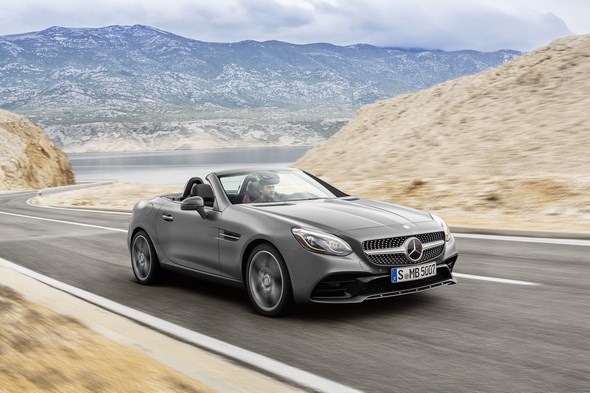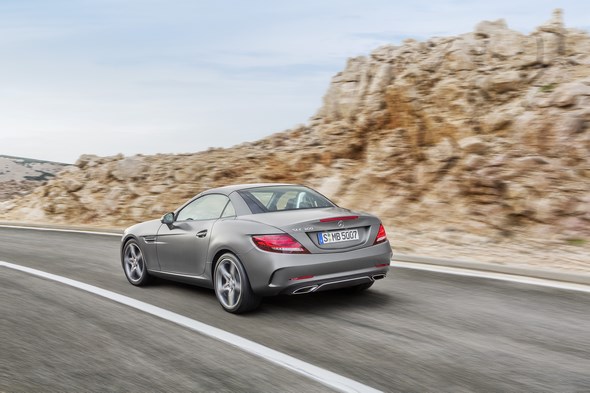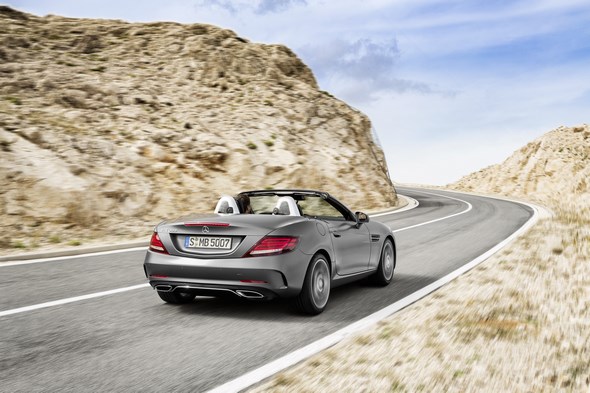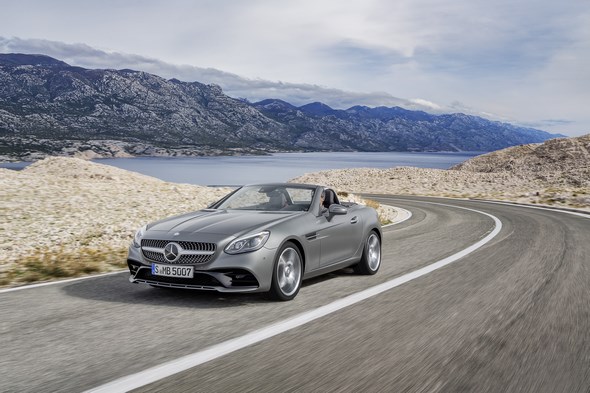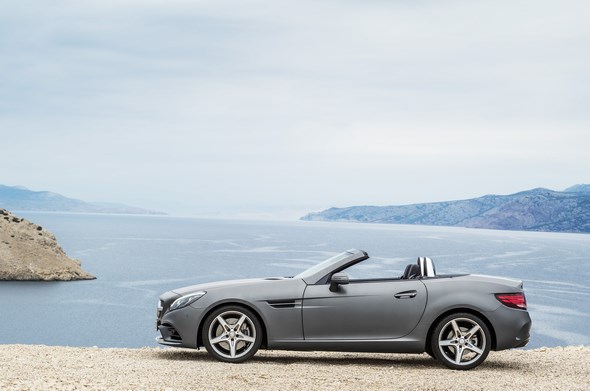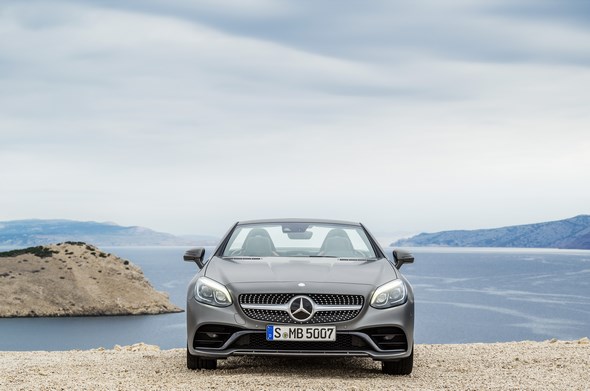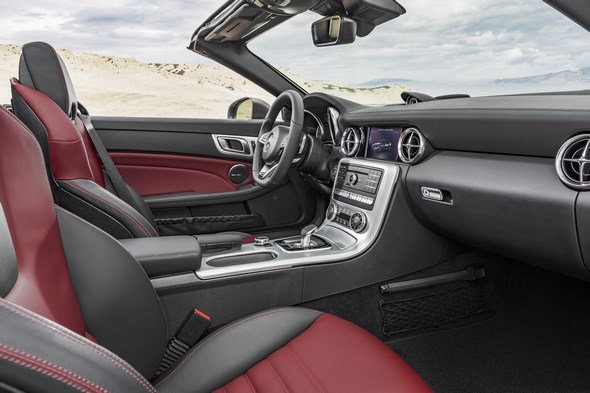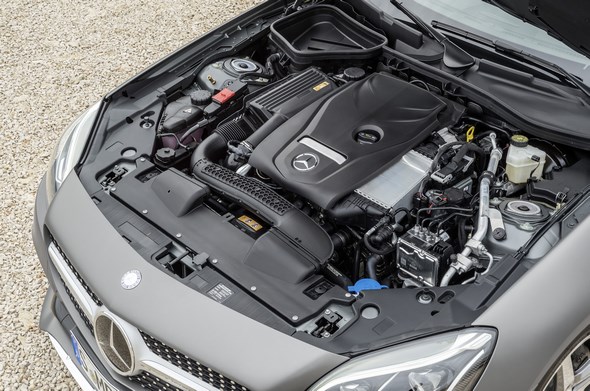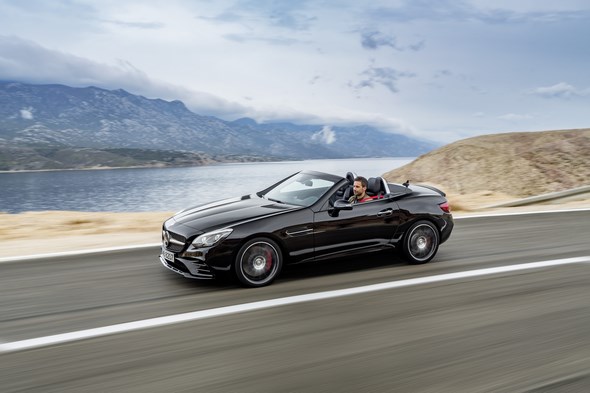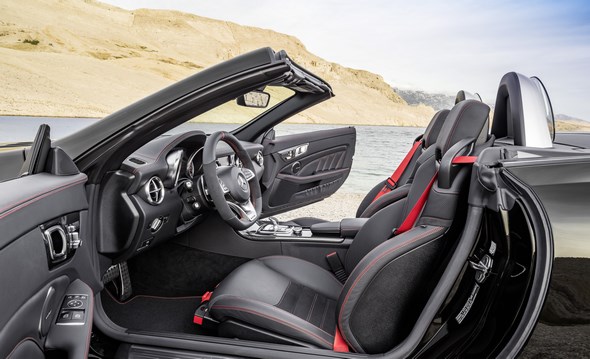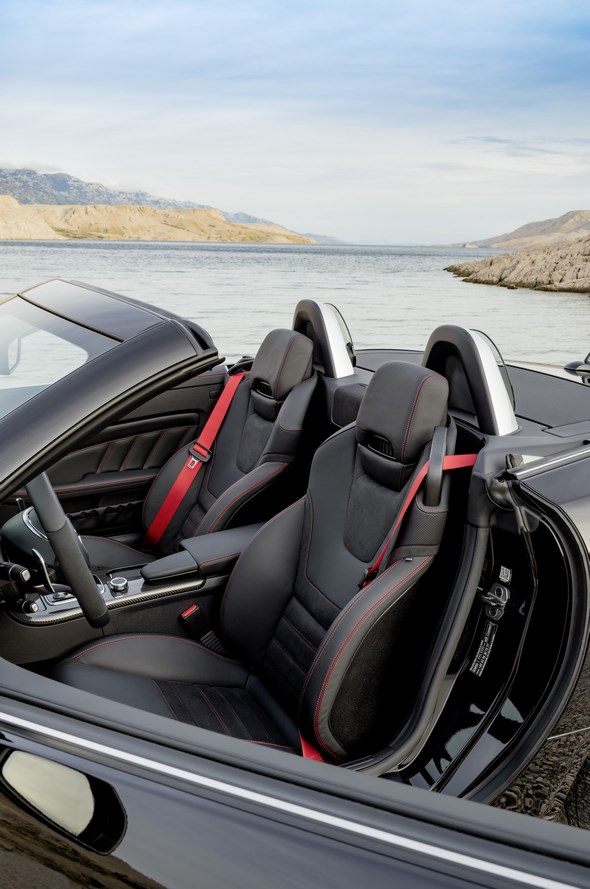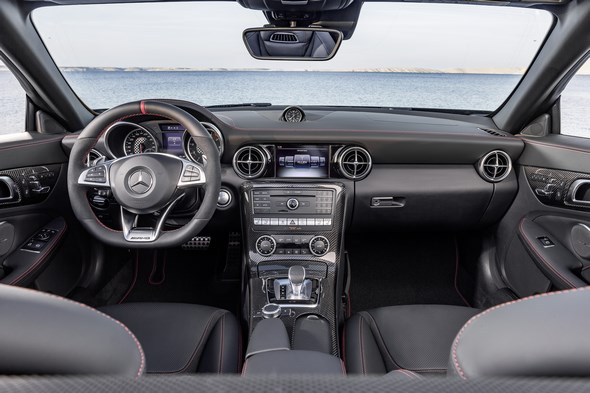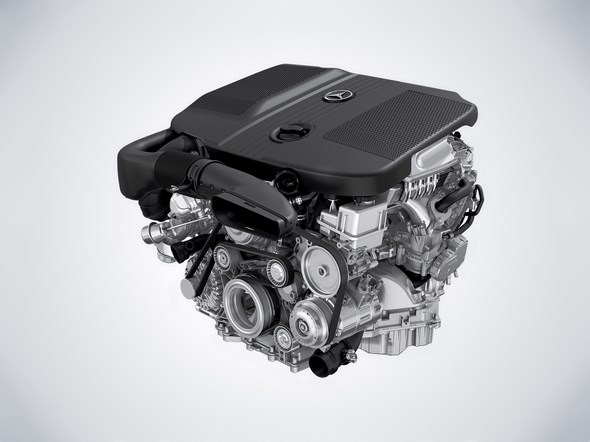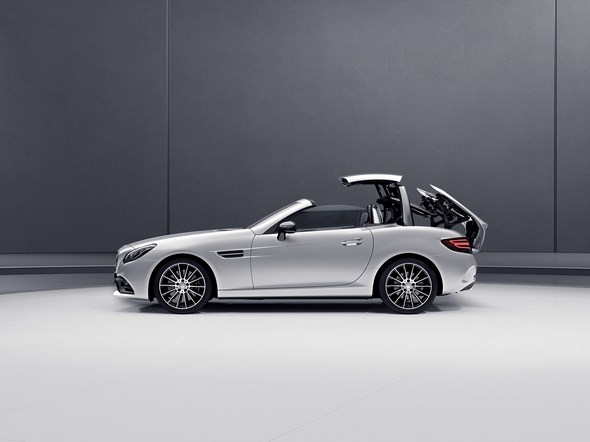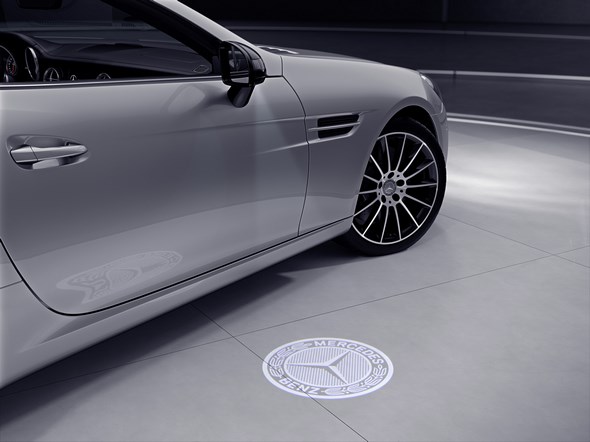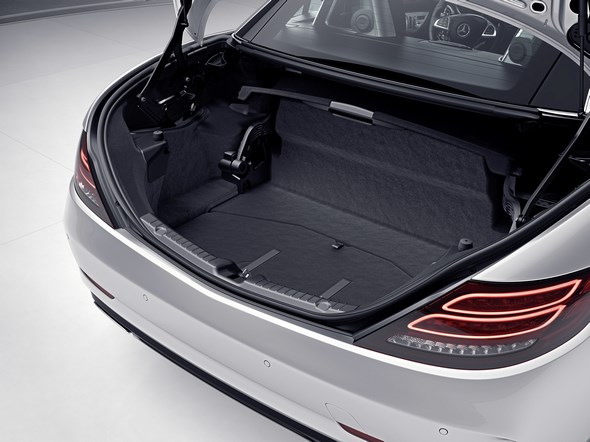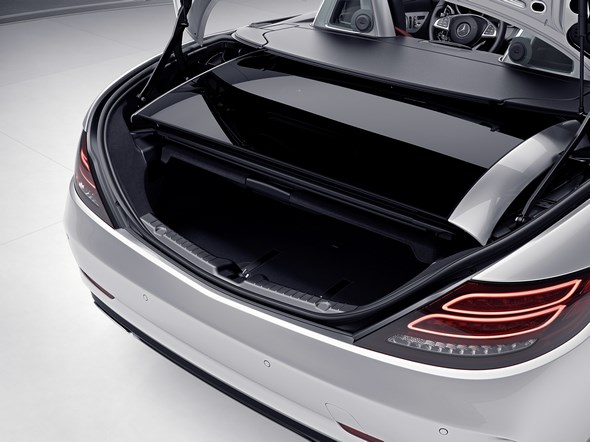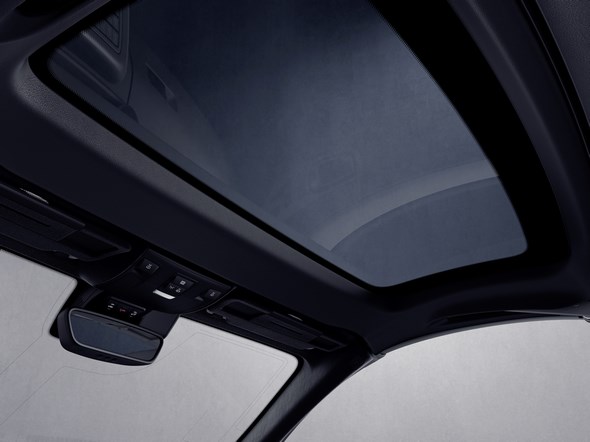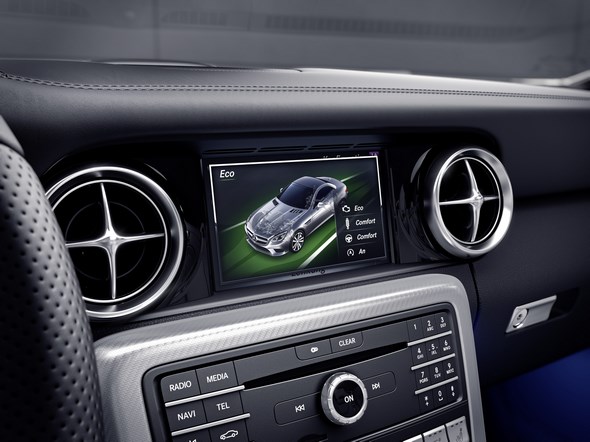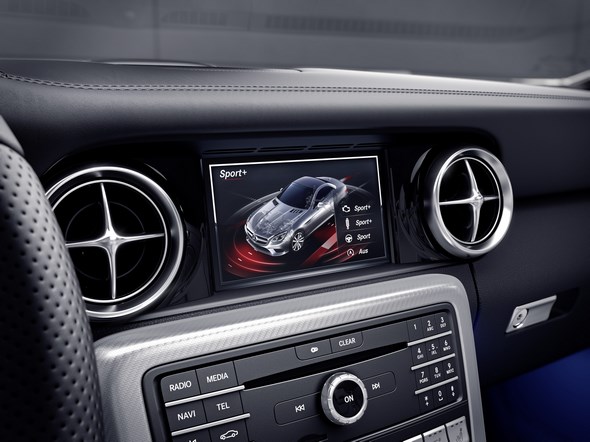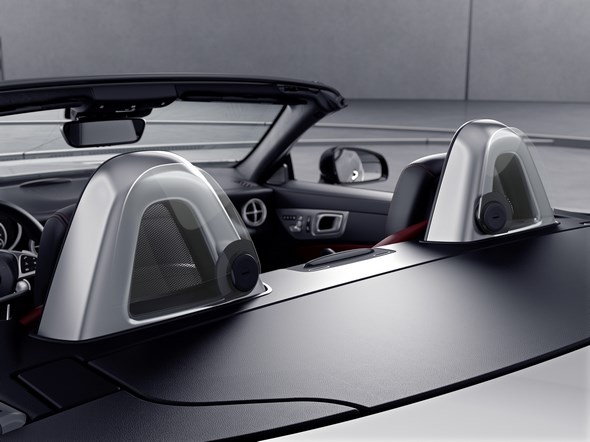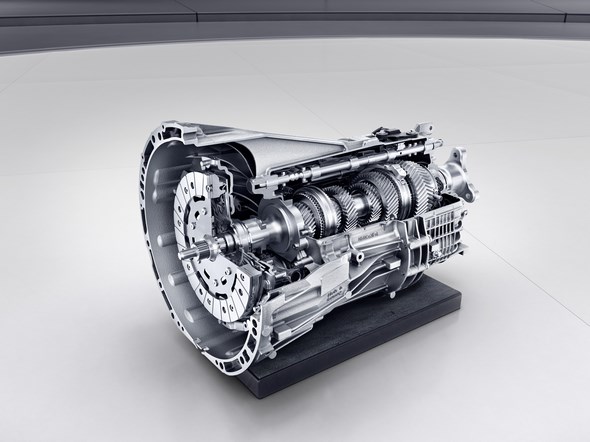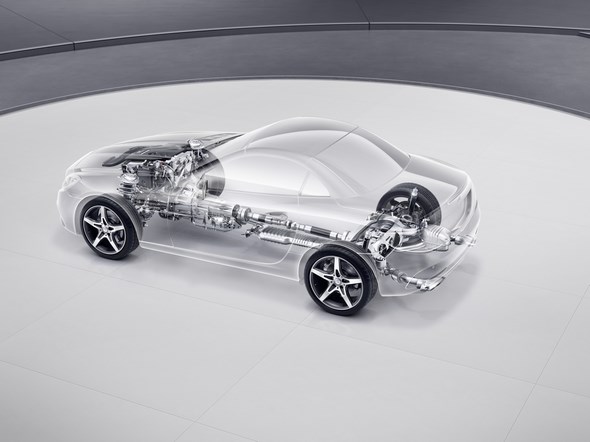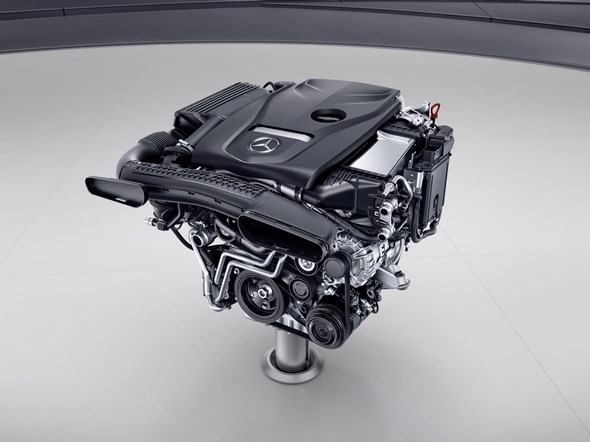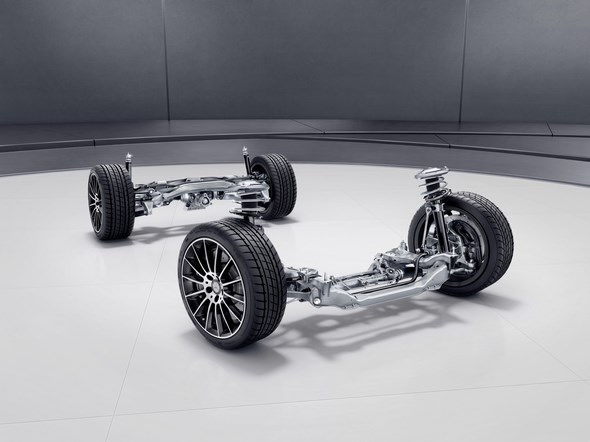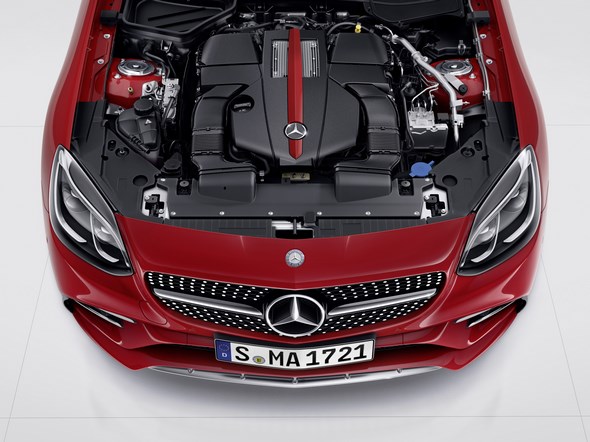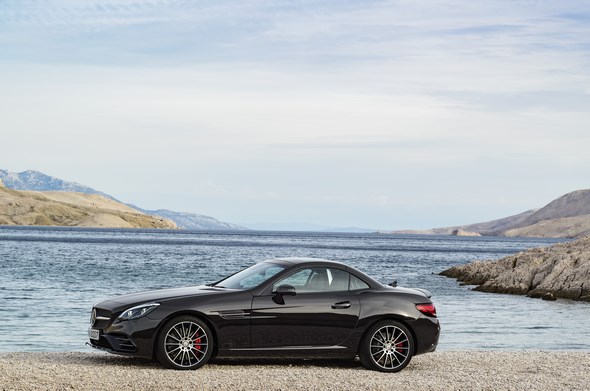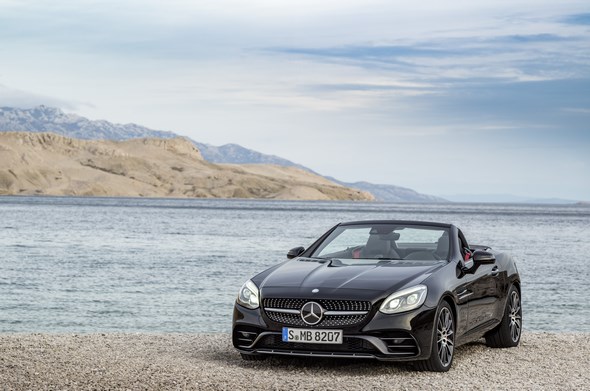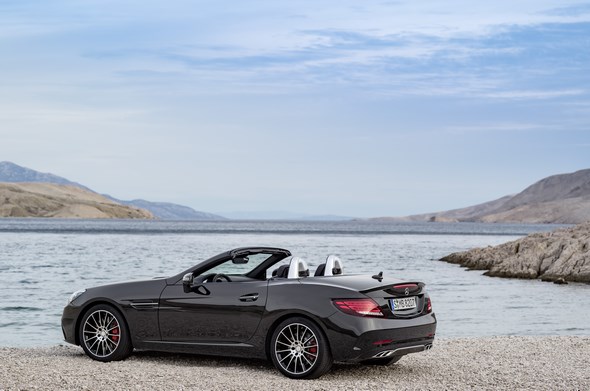The new Mercedes-Benz SLC

New name, new dynamic
The design
With all the essential charms of a roadster
As part of the facelift, the Mercedes-Benz designers have further honed the cult roadster’s sporty look. The new front section, where the steeply raked radiator grille elongates the appearance of the arrow-shaped bonnet, is particularly striking.
The interior of the post-facelift SLC has an even higher-quality look. Highlights include new light (standard) or dark aluminium trim parts with a carbon-fibre finish.
The instrument cluster has a new design too.
“The expressive design emphasises the sporty look of the SLC. With its powerful proportions and dynamically styled contours, the new roadster embodies the design philosophy of Sensual Purity.
The interior, too, designed with meticulous attention to detail, conveys modern luxury and typical roadster sportiness”, according to Gorden Wagener, Head of Design at Daimler AG.
All SLC models feature a diamond radiator grille as standard. On the entry-level model it is finished in black with an iridium silver louvre and chrome trim.
A more individual look is available in conjunction with the AMG Line or the Night package: here the diamond radiator grille is finished in chrome, and the colour of the louvre either remains iridium silver (AMG Line) or is high-gloss black (Night package).
Further features of the sporty front section include a bumper with striking air intakes, dynamically modelled contours and a high-quality chrome “wing” at its lower edge, along with distinctive headlamps.
The LED daytime running lamps are integrated into the headlamp units. The lenses are made from clear polycarbonate and have a scratchproof coating.
With the LED Intelligent Light System (optional extra), the edges and other parts of the headlamp housing are finished in black – conveying a high level of perceived quality and an effective sense of depth.
The side view of the SLC reveals the typical features of a roadster with a long bonnet, a passenger compartment that is set back and a short rear.
The silhouette is defined by the gently rising beltline and the sweeping curve of the roof, the powerfully moulded wheel arches, sporty 16 to 18-inch light-alloy wheels and the ventilation grilles in the front wing.
The latter feature a high-sheen chrome fin which has echoes of the legendary Mercedes-Benz 300 SL.
Powerful proportions define the rear section with its muscular wings. The rear bumper with its black diffuser, chrome touches and integral tailpipe trim elements signal the dynamic potential of the SLC.

The tail light units, which now have a narrower design, feature LED technology and are divided horizontally: the top and middle lights are the brake and tail light, and below them are the direction indicator and reversing light.
The boot lid has a pronounced arrow shape and the third brake light is positioned in the spoiler lip.
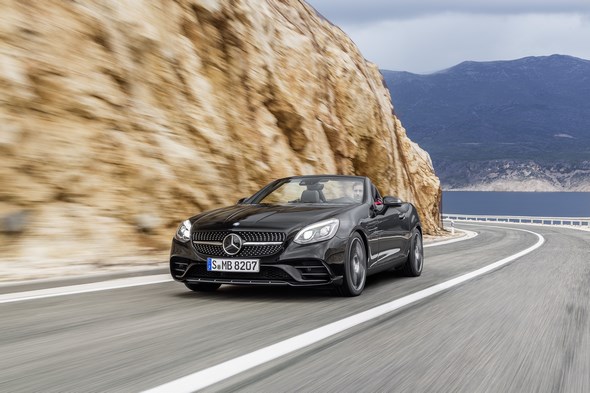
The interior: larger display and electroplated control elements
The interior of the post-facelift SLC has an even higher-quality look. Highlights include new light (standard) or dark aluminium trim parts with a carbon-fibre finish.
The instrument cluster has a new design too. The two tubular instrument surrounds now feature black dials. Red needles also add to the sporty, contemporary design.
A large multifunction colour TFT display with a screen diagonal of 4.5 inches (11.4 cm) is incorporated as standard between the two dials.
An analogue clock with a black dial is available as an option. The display between the two ventilation outlets in the centre console has been significantly increased in size: in conjunction with Audio 20 it now has a diagonal of 7 inches (17.8 cm) instead of 5.8 inches (14.7 cm).
The screen surround is in high-gloss black. Additional displays for vehicle parameters underline the sporty feel and are complemented by the engine data shown on round dials.
The electroplated control elements for the electrically adjustable seats (available in conjunction with the Memory package) and the electroplated steering wheel shift paddles, offered in conjunction with the AMG Line and Sports package, demonstrate an impressive attention to detail.
The new-generation sports steering wheel, perforated as standard in the grip area, and the DIRECT SELECT lever, embossed with the letters SLC (in conjunction with 9G-TRONIC), also help create a sporty, refined feel.
A new 3-spoke multifunction steering wheel in nappa leather/DINAMICA microfibre is available as an option.
The rim is flattened at the lower edge, the central grip area is trimmed with DINAMICA microfibre, and it features contrasting topstitching in red plus silver chrome trim and shift paddles.
The leather appointments have also been revised. With “sun-reflecting leather upholstery”, for example, the shoulder area of the seats features a new perforated design, while with “sun-reflecting nappa leather” the seats now feature transverse fluting in the selected appointments colour.
The piping and topstitching are in a contrasting colour. New to the range are the colours saddle brown (in conjunction with nappa leather and Exclusive nappa leather) and platinum white (new in conjunction with nappa leather and Exclusive nappa leather).
The ambient lighting (optional extra) has been extended to the footwell, creating a more generous sense of space. As well as solar red there are now two additional colours – polar blue and polar white.
Comfort appointments
Enjoying the open air in comfort
The SLC’s vario-roof combines open-top driving pleasure with uncompromised comfort in poor weather. Operating the electrohydraulic roof is now even more straightforward.
If while the roof is opening or closing the vehicle has to move off due to the traffic conditions, the process which was started when at a standstill can be continued up to a speed of approx. 40 km/h.
Likewise new is the semi-automatic boot separator.
SLC customers can choose between two roof variants: the panoramic vario-roof in tinted glass or the panoramic vario-roof with MAGIC SKY CONTROL, which is able to provide the perfect on-board climate.
The panoramic vario-roof with MAGIC SKY CONTROL can be switched from light to dark at the touch of a button; the light mode makes it almost completely transparent, so conveying a sense of open-air enjoyment, even in cold weather.
In its dark mode the roof provides welcome shade and, in bright sunshine, reduces the build-up of heat in the interior.
Operating the electrohydraulic roof is now even more straightforward. If while the roof is opening or closing the vehicle has to move off due to the traffic conditions, the process which was started when at a standstill can be continued up to a speed of approx. 40 km/h.
Also practical: the small side window behind the door can now be closed separately when the top is down, reducing wind noise.
Another new feature is the semi-automatic boot separator (in conjunction with the optional vario-roof convenience feature or optional KEYLESS-GO): if the separator is in the upper position for increased boot capacity, it automatically moves down when the roof is opened.
If there is not enough space for this because the boot is full of luggage, the roof does not open and the message “Close boot separator” appears in the instrument cluster.
Even with the top down, optional features ensure that the SLC is able to offer the perfect on-board climate.
Such features include seat heating and AIRSCARF, a neck-level heating system for driver and passenger that ensures that open-air driving remains a pleasurable experience, even when it’s cold outside.
Air outlets in the head restraints wrap an invisible scarf of warm air, as it were, around the head and neck area of the driver and passenger. The temperature can be set as desired to one of three levels.
There is also a choice of two draught-stops. An alternative to the conventional fixed-frame fabric draught-stop is offered by the two-piece AIRGUIDE draught-stop.
Comprising two pivoting transparent elements, this does not obstruct visibility to the rear. The pivoting sections can be swung round by hand into the space between the seats to deflect the air flow, so reducing the draught around the occupants’ head and neck area.
The two acrylic glass sections are attached to the reverse of the roll-over bars and can be individually positioned for the driver and passenger, as well as removed for cleaning.
All models except the SLC 250 d feature a reversible floor in the boot, which is fitted with two elastic straps for securing the dismounted draught-stop or other items.
The classic strengths of the SLC also include its well-designed boot, which at 335 litres has easily the highest capacity in this segment.
The powertrain
Connect four
The new entry-level model is the SLC 180 with an output of 115 kW (156 hp). It has an NEDC consumption figure of just 5.6 l/100 km and CO2 emissions of 127 g/km.
Positioned above this are the SLC 200 with an output of 135 kW (184 hp) and the SLC 300 with 180 kW (245 hp), both of which feature a 1991 cc four-cylinder engine.
The efficiency champion remains the 150 kW (204 hp) diesel model, the SLC 250 d, with a CO2 figure of 114 g/km.
The three four-cylinder petrol engines available for the new SLC belong to a family of modern engines bearing the internal designation M274.
They all share the third-generation direct injection system with spray-guided combustion. The system pressure is up to 200 bar with the pressure being variably optimised in line with the engine mapping.
Piezo injectors enable optimal mixture formation with up to five injections per power stroke.
This technology is supplemented with the rapid multi-spark ignition (MSI), which is able to trigger up to four sparks a millisecond as required.
The interplay of the two technologies allows optimum fuel utilisation with minimal emissions. All engines in this model series also feature an exhaust gas turbocharger.
With the sports exhaust system the sound experience can be intensified as the acoustics can be adjusted via an integral exhaust flap in conjunction with the DYNAMIC SELECT transmission modes.
The SLC 300 is fitted with the sports exhaust system as standard, while it is available for the SLC 200 in conjunction with 9G-TRONIC and the AMG Line/Sports package.
A diesel engine has been available in the Mercedes-Benz compact roadster since 2011. This four-cylinder unit with a displacement of 2143 cc has an output of 150 kW (204 hp) and offers torque of 500 Nm.
Fitted as standard with the 9G‑TRONIC automatic transmission, the SLC diesel can accelerate from zero to 100 km/h in 6.6 seconds and has a top speed of 245 km/h.
As the efficiency champion of the range, it offers fuel consumption of a mere 4.4 litres of diesel per 100 kilometres (NEDC combined), a figure that corresponds to CO2 emissions of 114 g/km.
The engine achieves its exemplary performance in terms of output and torque characteristics, efficiency and exhaust emissions, as well as the smooth ride that is particularly impressive for a diesel engine, through the use of innovative technologies such as fourth-generation common-rail technology with precise injection timing and two-stage turbocharging
The BlueTEC emission control system comprises an oxidation catalytic converter, a particulate filter, the AdBlue® injection system and an SCR catalytic converter.
Emissions of nitrogen oxides (NOx) are dramatically reduced by the injection of the urea solution AdBlue® and Selective Catalytic Reduction (SCR).
The SLC 180 and SLC 200 are fitted with a 6-speed manual transmission. The sport/comfort-oriented 9G-TRONIC automatic transmission is available for these models as an option and fitted as standard in the SLC 250 d and SLC 300.
The new model line-up at a glance:
| SLC 180 | SLC 200 | SLC 300 | SLC 250 d | SLC 43 | |
| Number of cylinders/ arrangement | 4/in-line | 4/in-line | 4/in-line | 4/in-line | 6/V |
| Displacement (cc) | 1595 | 1991 | 1991 | 2143 | 2996 |
| Rated output (kW/hp at rpm) | 115/156 at 5300 | 135/184 at 5500 | 180/245 at 5500 | 150/204 at 3800 | 270/367 at 5500-6000 |
| Rated torque (Nm at rpm) | 250 at 1200-4000 | 300 at 1200-4000 | 370 at 1300-4000 | 500 at 1600-1800 | 520 at 2000-4200 |
| NEDC consumption (l/100 km) urban/extra-urban/comb. | 7.4/4.5/5.6 (7.3/4.7/5.6) | 8.1/4.9/6.1 (7.5/4.7/5.7) | (7.5/4.7/5.8) | (5.2/3.9/4.4) | (10.7/6.2/7.8) |
| Combined CO2 emissions (g/km) | 127 (128) | 142 (133) | (134) | (114) | (178) |
| Efficiency class | B (B) | C (B) | (B) | (A) | (D) |
| Acceleration 0-100 km/h (s) | 7.9 (8.1) | 7.0 (6.9) | (5.8) | (6.6) | (4.7) |
| Top speed (km/h) | 226 (223) | 240 (237) | (250) | (245) | (250) |
In brackets: figures for version with 9G-TRONIC.
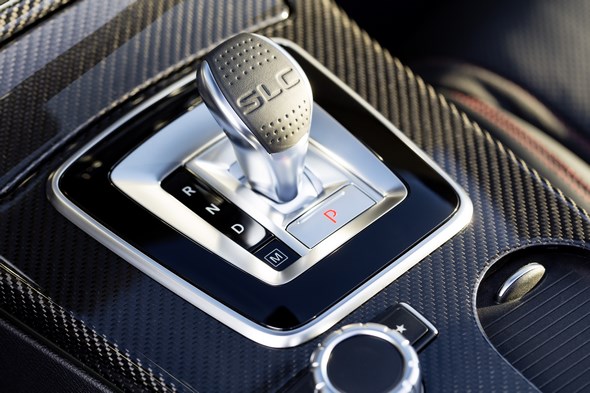
New 9G-TRONIC nine-speed automatic transmission: comfort and efficiency
The 9G-TRONIC, being used in the SLC for the first time, is a highly efficient transmission. The broad ratio spread of 9.15 for gears one to nine allows a clearly perceptible reduction in engine speed and is a decisive factor behind the high level of energy efficiency and ride comfort.
Shortened shift and response times ensure optimum spontaneity combined with exceptionally smooth gear changes.
Particularly in manual mode and the S and S+ modes, the 9G-TRONIC responds with significantly more spontaneity than the previous transmission used, so enhancing driving pleasure.
The exceptional drive comfort of the new 9G-TRONIC comes courtesy of a comprehensive package of measures.
These include a direct control system that enables short, barely perceptible gear changes. The combination of twin-turbine torsional damper and centrifugal pendulum technology in the torque converter ensures outstanding ease of shifting.
Together with the extended gear ratio spread, higher speeds can now be driven at lower engine speeds for even greater comfort.
A further focus of development work was the issue of “compact lightweight construction”. Despite two additional gears and a maximum transferable torque of as much as 1000 Nm, this transmission requires as little installation space as its predecessor and is, furthermore, lighter in weight.
The two-piece housing design has been retained: the torque converter housing is made of lightweight aluminium, while the transmission housing with weight-optimised plastic oil pan is made of an even lighter magnesium alloy.
Nine gears are implemented with a minimal number of planetary gear sets and shift elements: only four simple planetary gear sets and six shift elements are necessary.
Three speed sensors monitor operation and provide the transmission control system with corresponding data for effective shifting.
It is possible here for several gears to be jumped when accelerating or decelerating, should the driving conditions call for it.
To ensure the reliable and at the same time energy-efficient supply of long-lasting and shear-resistant, second-generation synthetic fuel economy engine oil, the new automatic transmission is equipped with two pumps.
The considerably smaller mechanical main pump, featuring an off-axis design, is located next to the main shaft and is chain-driven and fed by a separate electric auxiliary pump.
This design enables the flow of lubrication and coolant to be controlled actively on demand and also means that the 9G-TRONIC can benefit from a start/stop system.
Thanks to the world’s first direct control system in a planetary automatic transmission with nine gears, it has also been possible to significantly increase hydraulic efficiency within the transmission.
The higher number of gears and the broader gear ratio spread help to increase drive comfort and allow a significant enhancement to be achieved in terms of converting engine power into traction.
The chassis
With transmission mode selection
With DYNAMIC SELECT the vehicle characteristics of the SLC can now be adjusted instantly at the touch of a button, as the system modifies the characteristics of the engine, transmission, steering and suspension at the driver’s behest.
In conjunction with the Dynamic Handling package, the damping can also be adjusted.
The SLC is offered with a choice of three suspension options: a conventional steel suspension, a sports suspension with stiffer springs and dampers, and an electronically controlled, fully automatic damping system as a component of the Dynamic Handling package.
The wheel suspension is common to all: a three-link front axle ensures optimum wheel location, while a multi-link independent suspension with forged aluminium hub carriers takes on the same task at the rear.
With DYNAMIC SELECT the vehicle characteristics can be adjusted instantly at the touch of a button, as the system modifies the engine, transmission, steering and suspension at the driver’s behest.
DYNAMIC SELECT is a standard feature in the SLC 300 and SLC 250 d. In the SLC 180 and SLC 200, transmission mode selection is available in conjunction with the optional 9G-TRONIC.
The characteristics of the transmission modes:
- Eco (E), fuel-efficient setting with ‘gliding’ function
- Comfort (C), comfortable setting for long journeys or on rough roads
- Sport (S), sporty setting for a dynamic driving style
- Sport Plus (S+), extremely sporty setting — particularly suitable for flat road surfaces
- Individual (I) allows individual adjustment of the various parameters to suit the driver’s requirements
The relevant transmission mode is easily set using the DYNAMIC SELECT button in the upper control panel of the dashboard console.
The selected mode is shown on the colour multifunction display and also appears as a pop-up message on the head unit display.
Drivers who choose the Dynamic Handling package (optional extra), which features a 10 mm lower chassis, an adaptive damping system, the Direct-Steer system and ESP® Curve Dynamic Assist, can also use DYNAMIC SELECT to specify the damping force in Comfort, Sport and Sport+ mode.
Here the damping force at each individual wheel is automatically and continuously adapted to the current driving conditions.
The Direct-Steer system enhances the comfort and convenience of speed-dependent power steering by making the gear ratio also dependent upon the steering wheel angle.
This reduces, amongst other things, the steering movements and effort involved in parking and manoeuvring, while the vehicle is also noticeably more agile in its response to the steering angle, for instance on winding country roads.
ESP® Curve Dynamic Assist brakes the inside rear wheel on the bend if the system recognises that the vehicle is going into understeer.
As well as improving handling safety, the system improves the car’s driving dynamics.
The assistance systems
Added safety and improved visibility
A new feature for the SLC is the standard-fit Active Brake Assist, known until now as COLLISION PREVENTION ASSIST PLUS.
Available as an option is the LED Intelligent Light System, which adjusts automatically to the prevailing light and driving conditions.
Anti-dazzle continuous high beam comes courtesy of Adaptive Highbeam Assist Plus (optional extra).
In addition to the radar-based proximity warning and braking assistance provided by Adaptive Brake Assist, the Active Brake Assist system carries out autonomous braking to reduce the danger of rear-end collisions.
If the driver fails to act when a risk of a collision is detected, despite the warning lamp in the instrument cluster and the intermittent audible alert, the system will initiate autonomous braking at speeds of up to 200 km/h.
Active Brake Assist is thus able to reduce the severity of an accident involving vehicles that are travelling more slowly or stopping.
In an ideal situation it can even prevent the collision altogether. At speeds of up to 50 km/h, the system also brakes in response to stationary vehicles and is thus able to help prevent rear-end collisions at up to 40 km/h.
Blind Spot Assist and Active Lane Keeping Assist also remain available.
For optimum visibility on country roads and motorways, when cornering and on bends, the optional LED Intelligent Light System automatically adapts to all light and driving conditions.
The LED technology features low energy consumption, a long service life and a pleasant white light which approximates the daylight spectrum.
The five functions of the LED Intelligent Light System include motorway mode, cornering light function, camera-based active light function, roundabout light function and also the enhanced fog light function.
Adaptive Highbeam Assist Plus is also available for dazzle-free continuous high beam usage. When high beam is switched on, this system always makes the optimum headlamp range available.
The driver can concentrate on the traffic and does not have to continually switch between low beam and high beam.
Via a camera positioned behind the windscreen, Adaptive Highbeam Assist Plus detects other illuminated road users, for example oncoming vehicles or vehicles travelling in front, and adjusts the headlamps independently to the new traffic conditions.
A mechanism in the headlamp module masks that portion of the cone of light of the LED headlamps in which other vehicles are present, in order to prevent their drivers from being dazzled.
The driver can therefore leave the high-beam headlamps on at all times and use their full range without bothering or endangering other road users.
This function is active at speeds above 30 km/h when travelling in the dark on roads without street lighting.
Traffic Sign Assist is available in conjunction with COMAND Online. The system can recognise speed limit signs, no entry signs and no overtaking signs and shows the driver where any such restrictions start and finish.
If the driver attempts to make a wrong turn against the stipulated flow of traffic and the appropriate signs are detected, a visual and audible warning will be given.
Reversing into a parking space and manoeuvring can be made significantly safer and more straightforward with the optional reversing camera.
It is automatically activated when reverse gear is engaged and uses the display of the infotainment system to show the driver the area behind the vehicle with dynamic guide lines.
As an option, Parking Assist PARKTRONIC including Parking Guidance can make locating a parking space and parallel parking easier.
Infotainment
Intelligently networked
An extensive package of free Standard Services and Remote Online Services is available for the SLC under the heading of “Mercedes me connect”.
Standard Services include automatic emergency call (eCall), Accident Recovery and also breakdown assistance and after-sales service.
At the same time the infotainment systems COMAND Online and Audio 20 have been upgraded. With the Smartphone Integration package, compatible smartphones can be integrated into the vehicle via Apple® CarPlay®.
As a control and display system for navigation, phone, audio, video and internet, the COMAND Online infotainment system offers a range of new and extended features:
- 7-inch (17.8 cm) high-resolution media display
- Fast, dynamic hard disc navigation with realistic topographical map views and three years of free navigation updates
- Internet access from the stationary vehicle and unrestricted use of Mercedes-Benz Apps when on the move too (in conjunction with an appropriate mobile phone)
- DVD player
- Internet radio
- Bluetooth® interface with hands-free function, read function for text messages and audio streaming for music
- LINGUATRONIC voice-operated control system for audio, phone, navigation, music search and Mercedes-Benz Apps
- Two USB ports in centre armrest and one SD card slot in COMAND head unit
- Integral Media Interface connection for iPod® or iPhone®
- Transfer of addresses from mobile phone to Infotainment system
- Cover Art: album covers displayed in audio menu
- Mercedes-Benz emergency call
- Mercedes me connect Standard Services (Accident Recovery, Breakdown Management, Maintenance Management and Telediagnostics), Remote Retrieval of Vehicle Status via Remote Online
The Audio 20 CD entertainment system has also been upgraded. It now features a larger 7-inch (17.8 cm) display and can be combined with the Garmin® MAP PILOT navigation system; the navigation data here is input using an SD card.
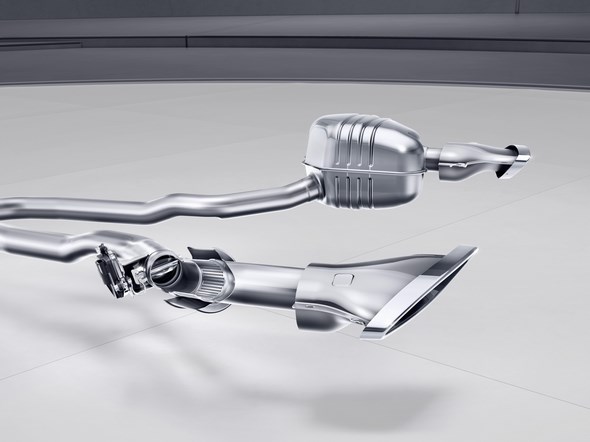
Optimised route guidance is also available via Live Traffic Information.
The new SLC is intelligently networked and “always on”. This is ensured by the standard-fit communications module (on-board SIM card) which enables the use of Mercedes me connect services.
The available Standard Services currently include Accident Recovery, Breakdown Management and Maintenance Management, as well as Telediagnostics, for example.
Also available as standard is the Mercedes‑Benz emergency call system.
If the Remote Online option is specified, navigation destinations, for example, can be sent to the vehicle from a computer or smartphone.
Further remote and tracking services include Geofencing, Vehicle Tracker, Parked Vehicle Locator, Remote Door Locking and Unlocking, and Remote Retrieval of Vehicle Status.
With the Smartphone Integration package, compatible smartphones can be integrated into the vehicle via Apple® CarPlay® and used via voice-operated control for example.
In addition, the other vehicle controls can also be used. Safe and comfortable use on the road is always ensured.
The history
The original is now 20 years old
The SLK’s debut as a standard production model back in 1996 caused a sensation. Not only was this a compact roadster from Mercedes-Benz, but it featured paintwork in the vibrant launch colour yellowstone and, instead of the traditional soft top, a tough vario-roof.
The SLK marked the start of a new era for the traditional Mercedes-Benz brand and its roof design served as a model for many other open-top vehicles.
In April 1994, roadster enthusiasts had been able to gain an initial impression of Mercedes-Benz’s vision for a compact roadster in Turin: the SLK design study was a show-stopper in brilliant silver, with a sporty yet somewhat spartan flair.
Short front and rear overhangs, plus a very pronounced wedge shape, epitomised the fun of active driving, while the two “powerdomes” running in the direction of travel along the bonnet represented a tribute to the granddaddy of all SLs from the 1950s.
The SLK concept car revealed considerable expanses of gleaming metal.
Just how seriously the SLK project was taken, right from the beginning, by the powers that be at Mercedes-Benz became clear at the Paris motor show of that same year.
A second design study, this time with a vario-roof, was presented here. This was an elegant hand-finished model in blue, with a blue leather interior and further comfort features such as an automatic transmission, air conditioning, power windows, hi-fi system and so on.
The SLK set trends, even before going into standard production
The automotive enthusiasts began to queue up. For many, the SLK appeared to herald the future.
Mercedes-Benz had done something completely unexpected and proved that a small and inexpensive roadster can offer tremendous fun at the wheel and yet still be an absolutely serious contender when it comes to safety and quality.
By doing this, the SLK studies had opened up a new niche in the market and made the SLK a trendsetter, even before it went into series production.
Its moment came in 1996: series launch of the new SLK, with the internal designation R 170, at the Turin motor show.
A particular focus of attention was the fully retractable vario-roof, which made the SLK a car for all year round, without any ifs and buts.
Thanks to an intelligent electrohydraulic system, this disappeared completely into the boot in just 25 seconds, opening up the view to the sky.
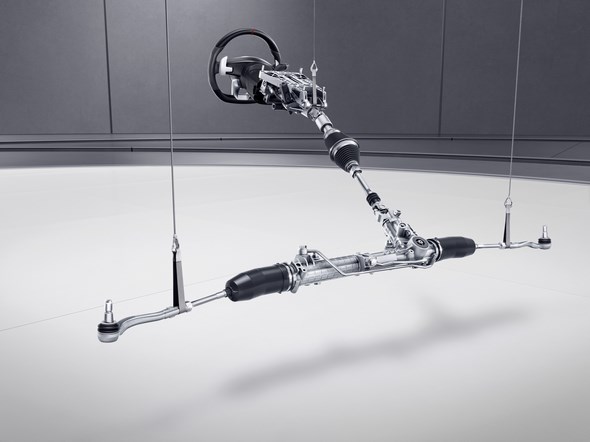
Engines with an output range from 136 to 354 hp
The sportive talents of the SLK were given free rein by two engine variants – a four-cylinder unit with a displacement of two litres and an output of 100 kW (136 hp), plus a mechanically supercharged 2.3-litre engine, also with four cylinders but in this case with 142 kW (193 hp).
From the spring of 2000 the two-litre engine was also fitted with a mechanical supercharger, so pushing 120 kW (163 hp) to its rear wheels.
The engine range was later expanded by the addition of two six-cylinder versions: the SLK 320 with an output of 160 kW (218 hp) and the SLK 32 AMG with 260 kW (354 hp).
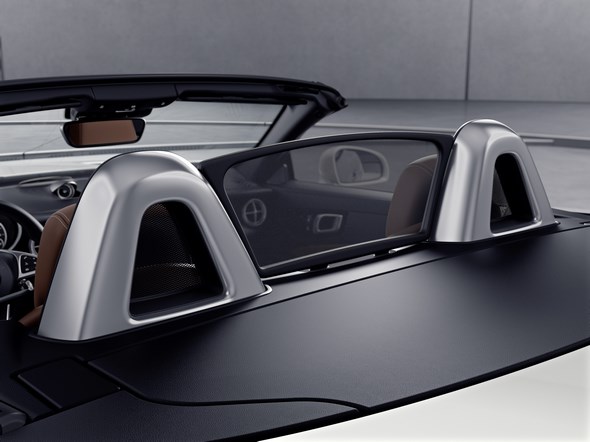
The SLK continues to evolve
In February 2000, Mercedes-Benz significantly upgraded the specification of the roadster to include innovations such as the Electronic Stability Program (ESP®) or the six-speed manual transmission among its standard equipment.
New bumpers and side skirts made it even more dynamic in appearance. In addition, all detachable body parts and even the door handles were now painted in the vehicle colour, giving the body a particularly coherent look in terms of both shape and colour.
New tail lights, stainless steel trim on the exhaust tailpipe and a painted radiator grille likewise added character to the design of the SLK.
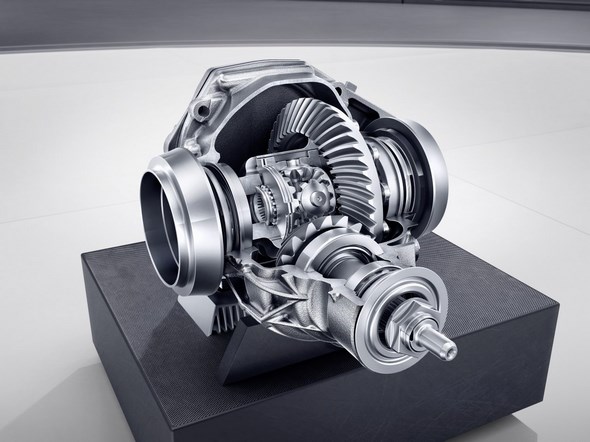
Even more driving enjoyment with the second-generation SLK
Spring 2004 brought the debut of the second generation of the SLK (internal model series designation R 171) – even sportier, even more dynamic and offering even more fun at the wheel.
Powerful engines, a redesigned suspension, direct steering and a precise six-speed transmission meant that the driving experience in the second-generation SLK was characterised by its enhanced agility.
Mercedes-Benz also celebrated the world premiere of its AIRSCARF neck-level heating system. At the touch of a button, this generates warm air that flows out of the head restraints.
This made it possible to drive the SLK open even in cooler weather conditions, so allowing open-air enjoyment of the roadster all year round.
The mechanism of the vario-roof was also modified by comparison with the previous model.
The rear window now rotated within its frame to allow the curvature of the rear window, when folded, to face upwards, thus increasing the capacity of the boot.
The third generation once again sets the benchmark
This trend is once again followed by the third model generation, launched in January 2011 under the internal designation R 172.
The SLK melds fleet-footed sportiness with stylish comfort, distinctive sports car design with absolute viability for everyday use and top performance with an ecological approach.
From April 2016 it will be appearing with significant technical and visual enhancements under the name SLC.
The name change acknowledges the close relationship with the C‑Class, with which the roadster shares much of its technology.
Chronicle of a model: Mercedes-Benz SLK and SLC
- 1994: Design studies in Turin and Paris
- 1996: World premiere of the SLK at the Turin Motor Show
- 2000: Comprehensive facelift for the SLK
- 2004: World premiere of the second-generation SLK at the
Geneva Motor Show - 2008: Facelift for the second-generation SLK
- 2011: Third generation of the SLK
- 2016: Facelift for the third-generation model, renamed as the SLC
To coincide with its 20-year anniversary, the archetypal compact roadster is to be relaunched in April 2016 with a new name – the SLC – as well as significantly optimised technology and an enhanced look.
The name change acknowledges the close relationship with the C-Class. There are new additions to the model line-up – the sporty top-of-the-line Mercedes-AMG SLC 43 and the entry-level SLC 180.
In visual terms, stand-out features include the standard-fit diamond radiator grille and the LED Intelligent Light System (optional extra).
Prices now start at €34,926.50[1] for the new SLC 180 entry-level model with an output of 115 kW (156 hp).
The new Mercedes-Benz SLC has an impressive heritage to live up to: its predecessor, the SLK, which was launched in 1996, won fans around the world and achieved sales of around 670,000 units.
Comprehensively refined and with a model line-up ranging from the high-torque and economical SLC 250 d to the sporty, high-performance Mercedes-AMG SLC 43, the new model has what it takes to build on that success.
The SLC 250 d, SLC 300 and SLC 43 feature the sport/comfort-oriented 9G-TRONIC automatic transmission as standard, while it is available as an option for the new 115 kW (156 hp) SLC 180 and for the SLC 200.
Ola Källenius, Member of the Board of Management of Daimler AG, Mercedes-Benz Cars Sales & Marketing: “In 1996 Mercedes-Benz redefined the roadster with its innovative vario-roof, and combined open-air driving pleasure with uncompromised comfort in poor weather.
The renamed compact roadster remains the ideal combination of passion and rational common sense, appealing to both the heart and the mind”.
As part of the facelift, the Mercedes-Benz designers have further honed the cult roadster’s sporty look. The new front section, where the steeply raked radiator grille elongates the appearance of the arrow-shaped bonnet, is particularly striking.
All SLC models feature a diamond radiator grille as standard. Its interior, post facelift, has an even higher-quality look. Highlights include new light (standard) or dark aluminium trim parts with a carbon-fibre finish. The instrument cluster has a new design too.
With DYNAMIC SELECT the vehicle characteristics can be adjusted instantly at the touch of a button, as the system modifies the engine, transmission, steering and suspension at the driver’s behest.
The new model line-up at a glance:
| SLC 180 | SLC 200 | SLC 300 | SLC 250 d | SLC 43 | |
| Number of cylinders/ arrangement | 4/in-line | 4/in-line | 4/in-line | 4/in-line | 6/V |
| Displacement (cc) | 1595 | 1991 | 1991 | 2143 | 2996 |
| Rated output (kW/hp at rpm) | 115/156 at 5300 | 135/184 at 5500 | 180/245 at 5500 | 150/204 at 3800 | 270/367 at 5500-6000 |
| Rated torque (Nm at rpm) | 250 at 1200-4000 | 300 at 1200-4000 | 370 at 1300-4000 | 500 at 1600-1800 | 520 at 2000-4200 |
| NEDC consumption (l/100 km) urban/extra-urban/comb. | 7.4/4.5/5.6 (7.3/4.7/5.6) | 8.1/4.9/6.1 (7.5/4.7/5.7) | (7.5/4.7/5.8) | (5.2/3.9/4.4) | (10.7/6.2/7.8) |
| Combined CO2 emissions (g/km) | 127 (128) | 142 (133) | (134) | (114) | (178) |
| Efficiency class | B (B) | C (B) | (B) | (A) | (D) |
| Acceleration 0-100 km/h (s) | 7.9 (8.1) | 7.0 (6.9) | (5.8) | (6.6) | (4.7) |
| Top speed (km/h) | 226 (223) | 240 (237) | (250) | (245) | (250) |
| Price from (euros)1 | 34,926.50 (37,425.50) | 39,805.50 (42,304.50) | (46,380.25) | (43,524.25) | (59,886.75) |
In brackets: figures for version with 9G-TRONIC.
1Recommended retail price in Germany incl. VAT
Drive system: individual driving characteristics with DYNAMIC SELECT
The new entry-level model is the SLC 180 with an output of 115 kW (156 hp). It has an NEDC consumption figure of just 5.6 l/100 km and CO2 emissions of 127 g/km.
Positioned above this are the SLC 200 with an output of 135 kW (184 hp) and the SLC 300 with 180 kW (245 hp), both of which feature a 1991 cc four-cylinder engine.
The efficiency champion remains the 150 kW (204 hp) diesel model, the SLC 250 d, with a CO2 figure of 114 g/km.
Driving Performance is the AMG brand promise – and the Mercedes-AMG SLC 43 lives up to it in impressive style.
The new model combines a 270 kW (367 hp), 520 Nm, 3.0-litre V6 biturbo engine with a modified version of the AMG sports suspension familiar from the Mercedes-AMG SLK 55, and the combination is reflected in the sporty performance figures, with the SLC 43 accelerating from 0 to 100 km/h in 4.7 seconds.
The SLC 180 and SLC 200 are fitted with a 6-speed manual transmission. The sport/comfort-oriented 9G-TRONIC automatic transmission is available for these models as an option and fitted as standard in the SLC 250 d, SLC 300 and SLC 43.
With DYNAMIC SELECT the vehicle characteristics can be adjusted instantly at the touch of a button, as the system modifies the engine, transmission and steering at the driver’s behest.
The five modes – “Comfort”, “Sport”, “Sport+”, “Eco” and “Individual” – are easy to select using the DYNAMIC SELECT button in the upper control panel on the dashboard console.
The selected mode is shown on the colour multifunction display and also appears as a pop-up message on the head unit display.
DYNAMIC SELECT is a standard feature in the SLC 300 and SLC 250 d. In the SLC 180 and SLC 200, transmission mode selection is available in conjunction with the optional 9G-TRONIC.
Drivers who choose the Dynamic Handling package (optional extra), which features a 10 mm lower chassis, an adaptive damping system, the Direct-Steer system and ESP® Curve Dynamic Assist, can also use DYNAMIC SELECT to specify the damping force in Comfort, Sport and Sport+ mode.
Here the damping force at each individual wheel is automatically and continuously adapted to the current driving conditions.
Assistance and safety systems: a comprehensive range
A new feature for the SLC is the standard-fit Active Brake Assist, known until now as COLLISION PREVENTION ASSIST PLUS.
In addition to a visual proximity warning and an additional audible collision warning, it includes Adaptive Brake Assist, which can help prevent collisions by boosting the brake pressure to suit the situation.
Should the risk of collision remain and the driver fails to react, the system can trigger autonomous braking.
Blind Spot Assist and Active Lane Keeping Assist also remain available.
For optimum visibility on country roads and motorways, when cornering and on bends, the optional LED Intelligent Light System automatically adapts to all light and driving conditions.
Adaptive Highbeam Assist Plus is also available for dazzle-free continuous high beam usage. This system always automatically sets the optimum headlamp range.
The driver can concentrate on the traffic and does not have to continually switch between low beam and high beam.
If the front passenger seat is unoccupied or a child seat is detected, the front passenger airbag is automatically deactivated.
This helps prevent small children from being injured by the front passenger airbag deploying. The reliable recognition function uses a pressure sensor.
Comfort appointments: vario-roof now even easier to operate
The SLC’s vario-roof combines open-top driving pleasure with uncompromised comfort in poor weather. Operating the electrohydraulic roof is now even more straightforward.
If while the roof is opening or closing the vehicle has to move off due to the traffic conditions, the process which was started when at a standstill can be continued up to a speed of approx. 40 km/h.
Another new feature is the semi-automatic boot separator (in conjunction with the optional vario-roof convenience feature or optional KEYLESS-GO): if the separator is in the upper position for increased boot capacity, it automatically moves down when the roof is opened.
Even with the top down, optional features ensure that the SLC is able to offer the perfect on-board climate.
These features include heated seats and AIRSCARF, the neck-level heating system for the driver and passenger, ideally in combination with one of the two available draught-stops.
The small side window behind the door can now be closed separately when the top is down, reducing wind noise.
A feature that continues to be unique to the SLC is the panoramic vario-roof with MAGIC SKY CONTROL – this glass roof is lightened or darkened at the touch of a button.
This means that it provides an open-air feeling at any time, but when required gives welcome shade under a hot sun.
The classic strengths of the SLC also include its well-designed boot, which at 335 litres has easily the highest capacity in this segment.
Infotainment: extended functions for COMAND Online
As a control and display system for navigation, phone, audio, video and internet, the COMAND Online infotainment system offers a wide range of new and extended features.
These include the 7-inch (17.8 cm) high-resolution TFT display and internet access from the stationary vehicle, plus unrestricted use of the Mercedes-Benz Apps when on the move too (in conjunction with an appropriate mobile phone).
The new SLC is intelligently networked and “always on”. This is ensured by the standard-fit communications module (on-board SIM card) which enables the use of Mercedes me connect services.
The available Standard Services currently include Accident Recovery, Breakdown Management and Maintenance Management, as well as Telediagnostics, for example.
The Audio 20 CD entertainment system has also been upgraded. It now features a larger 7-inch (17.8 cm) display and can be combined with the Garmin® MAP PILOT navigation system; the navigation data here is input using an SD card. Optimised route guidance is also available via Live Traffic Information.
[1] Recommended retail price in Germany incl. VAT
The new Mercedes-AMG SLC 43
Performance roadster from Affalterbach
There need be no contradiction between high driving dynamics and low fuel consumption. This is proved by the new Mercedes-AMG SLC 43: thanks to the combination of 3.0-litre V6 biturbo engine and 9G-TRONIC sports transmission, the 270 kW (367 hp) roadster consumes just 7.8 litres of fuel per 100 kilometres (NEDC, combined).
Consequently, the open-top two-seater not only uses 0.6 l/100 km less than its predecessor, the SLK 55 with V8 naturally aspirated engine, but is also the most efficient six-cylinder performance roadster on the market.
The specially developed suspension and model-specific mountings for engine and rear-axle gear unit are designed for high lateral acceleration and low roll.
Further enhanced driving dynamics are optionally available with the AMG RIDE CONTROL suspension with adaptive adjustable damping and the Handling package with mechanical limited-slip differential on the rear axle.
Compact, powerful and economical: “The new Mercedes-AMG SLC 43 unites the classic virtues of a roadster with exemplary efficiency.
Weighing less and with lower fuel consumption, the new SLC 43 delivers a similar performance to the SLK 55 on the race track.
This vehicle provides typical AMG driving pleasure in a compact open-top two-seater in line with the needs of today’s market”, says Mercedes-AMG chairman Tobias Moers.
With its maximum power of 270 kW (367 hp) and peak torque of 520 newton metres, the 3.0-litre V6 biturbo engine can deliver impressive performance: sprinting from rest to 100 km/h in 4.7 seconds, its top speed is electronically limited at 250 km/h.
The key factors behind the snappy, agile roadster driving experience are the newly developed front and rear axles, new engine/rear-axle gear unit mountings, stiff elastokinematics and highly precise steering.
Even greater transverse dynamics are made possible by the optional Handling package with mechanical limited-slip differential on the rear axle.
New model, new nomenclature
The new SLC 43 represents the entry point into the current roadster world of AMG. As well as being renamed from SLK to SLC, the open two-seater will feature the new AMG nomenclature.
The established AMG convention of a two-digit number underscores the SLC’s clear affiliation to the AMG portfolio.
In combination with its overall “engineered in Affalterbach” package of typical AMG driving dynamics, engine response and high efficiency, the SLC 43 is thus very competitively positioned in the segment.
43 here stands for the 3.0-litre V6 biturbo engine that has been further developed by the AMG engineers.
The Mercedes-AMG SLC 43 is therefore the first V6 model from Affalterbach to feature the new nomenclature. This will gradually be introduced across the future AMG model range.
The key data
| Mercedes-AMG SLC 43 | |
| Engine | V6 biturbo |
| Displacement | 2996 cc |
| Output | 270 kW (367 hp) at 5500-6000 rpm |
| Peak torque | 520 Nm at 2000-4200 rpm |
| Fuel consumption – urban/extra-urban/combined | 10.7/6.2/7.8 l/100 km |
| CO2 emissions – combined | 178 g/km |
| Efficiency class | D |
| Kerb weight (according to DIN/EC) | 1520*/1595** |
| Acceleration 0-100 km/h | 4.7 s |
| Top speed | 250 km/h*** |
* Ready-to-drive condition (fuel tank 90% full, not incl. driver and luggage);
** Ready-to-drive condition (fuel tank 90% full, incl. driver (68 kg) and luggage (7 kg));
*** Electronically limited
The highlights
- 0-litre V6 biturbo engine with AMG-specific engine management and increased charge-air pressure
- 9G-TRONIC with double-declutching function on downshifts and thrillingly short response times in the Sport+ transmission mode or in manual gearshift mode
- Specially developed front and rear axles with new elastokinematics
- Stiffer mountings for engine and rear-axle gear unit
- High-performance braking system with larger brake discs
- AMG design with specific front and rear aprons, exhaust tailpipes
- Diamond radiator grille in chrome with louvre in high-gloss black
- 18-inch AMG multi-spoke light-alloy wheels, painted in high-gloss black with high-sheen
- Instrument cluster in chequered flag design with 280 km/h scale
- Multifunction sports steering wheel in nappa leather with perforations in grip area, flattened bottom section, with red contrasting topstitching
- Upholstery in black nappa leather / DINAMICA microfibre with sports seat upholstery layout and red piping and topstitching, with model-specific door centre panel
The key options
- Handling package with mechanical limited-slip differential on rear axle
- AMG RIDE CONTROL sports suspension with adaptive adjustable damping
- Night package with front splitter and trim strip in diffuser in high-gloss black as well as black chrome-plated exhaust tailpipe trim elements
- Performance steering wheel in black nappa leather/DINAMICA microfibre, with flattened bottom section, red contrasting topstitching and red 12 o’clock marking
High on power, low on consumption: the 3.0-litre V6 twin-turbo engine
The new SLC models from Mercedes-Benz come exclusively with a four-cylinder powerplant.
The six-cylinder engine is reserved for the SLC 43 from Mercedes-AMG: the 3.0-litre V6 biturbo engine is characterised by a high power output together with low consumption and emissions.
Installed close to the engine, the two turbochargers are especially spontaneous in their response. The high power output of 270 kW (367 hp) is attributable to, among other things, the 1.1 bar charge-air pressure.
Especially tough and therefore wear-resistant, the NANOSLIDE® coating on the cylinder liners also reduces friction, thereby contributing to higher efficiency.
The same applies to the spray-guided multiple injection with up to 200 bar fuel pressure. The AMG powerplant can be identified by the red aluminium insert in the engine cover.
Short shift times: the 9G-TRONIC
The 9G-TRONIC transmission is specially matched to the demands of the SLC 43. By specifically adapting the software, the AMG developers have been able to shorten the shift times significantly.
The multiple downshift allows even faster short bursts of speed, while the double-declutching function in the “Sport” and “Sport+” transmission modes makes for an even more emotive driving experience.
In “Sport+” mode, partial ignition interruptions provide even faster gearshifts.
The standard-fit shift paddles allow lightning-fast manual shifting of the automatic transmission without the driver needing to take their hands off the steering wheel.
Shifting in “Manual” mode, which is activated using a separate button next to the selector lever, is twice as fast as in the other transmission modes.
Moreover, the transmission stays in the selected gear and does not automatically shift up when the engine speed reaches the limit.
Two options: the sports suspension
With the standard sports suspension or the optional AMG RIDE CONTROL sports suspension with adjustable damping, the Mercedes-AMG SLC 43 offers two suspension options designed for high lateral acceleration and reduced roll.
Common to both suspensions are the specially developed front and rear axles, which guarantee precise wheel location and high camber stability on compression and rebound.
The three-link front axle has been provided with stiffer steering knuckles, improved elastokinematics and increased negative camber.
In combination with the likewise newly developed wishbone guide bearings, this design results in significantly more agile cornering, more precise and direct suspension feedback from the road and fast cornering speeds.
The four-link rear axle with optimised elastokinematics, increased negative camber and special forged-aluminium track rods not only improves the driving dynamics, but also makes the SLC 43 more controllable when driven at the limit.
The special AMG mountings for engine and rear-axle gear unit offer the ideal compromise between handling and comfort.
They also contribute to the snappy and highly stable driving impression given by the roadster.
With its automatic adjustable damping system, the optional AMG RIDE CONTROL sports suspension allows an even more personalised suspension set-up, with each wheel being individually electronically controlled.
The three suspension settings “Comfort”, “Sport” and “Sport+” can be selected by the driver via the transmission modes using the DYNAMIC SELECT button.
Optimal traction: the optional rear-axle limited-slip differential
The mechanically controlled AMG limited-slip differential on the rear axle makes for improved traction and handling in all driving situations, particularly when the driver adopts a sporty driving style.
This is achieved by reducing the slip on the inside driven wheel when cornering, without control intervention in the brakes.
When there is a difference in rotational speed between the rear wheels, the torque is distributed to the wheel with the better grip in order to reduce wheel spin.
The benefits are:
- better acceleration out of bends
- better acceleration from rest
- greater stability on braking and at high speed
Safe and fade-resistant: the high-performance braking system
The AMG high-performance braking system is characterised by excellent deceleration, high fade resistance and precise brake control.
Large-sized, internally ventilated and perforated brake discs are capable of absorbing plenty of braking energy and quickly dissipating the arising heat.
Lightweight aluminium brake callipers reduce the unsprung mass, resulting in improved handling and comfort.
Characteristics at the tap of a finger: AMG DYNAMIC SELECT
With the five DYNAMIC SELECT transmission modes “Eco”, “Comfort”, “Sport”, “Sport+” and “Individual”, the driver can change the characteristics of the SLC 43 at the tap of a finger.
The available range extends from efficient and comfortable to extremely sporty. This modifies key parameters, such as the response of the engine, transmission, suspension and steering.
The modes are selected using a button in the centre console control panel.
AMG DYNAMIC SELECT at a glance
- “Eco” transmission mode: all parameters are programmed for maximum efficiency. The ECO start/stop and gliding functions (overrun mode for fuel-efficient driving) are activated.
- “Comfort” transmission mode: comfortable and fuel-efficient driving, e.g. thanks to early upshifts. Suspension and steering are set up for an emphasis on comfort.
- “Sport” transmission mode: sporty characteristics thanks to a more agile response to accelerator commands, shorter shift times, earlier downshifts and more emotive gearshifts owing to double-declutching. A more dynamic set-up of suspension and steering.
- “Sport+” transmission mode: extremely sporty characteristics thanks to an even more agile throttle response, increased acoustic emphasis on double-declutching on downshifts as well as selective torque control on upshifts with cylinder suppression for optimal shift times. Increased idle speed for faster pull-away. An even more dynamic set-up for suspension, steering and drivetrain.
- “Individual” transmission mode: personalised set-up of drive, suspension, steering, air conditioning and ECO start/stop function.
Independently of the DYNAMIC SELECT transmission modes, the driver has the option of pressing the “M” button to switch directly to manual mode, in which gearshifts are executed exclusively using the shift paddles on the steering wheel.
Further personalisation of the driving dynamics is possible by means of the ESP® button, which offers a choice between three control strategies for the Electronic Stability Program:
- ESP® “ON”: early system intervention without adversely affecting the sporty character
- ESP® “SPORT HANDLING MODE”: late system intervention for a sporty driving style
- ESP® “OFF”: system deactivated for an extremely sporty driving style on closed racing circuits
Direct and with clear feedback: speed-sensitive sports steering
With its permanent, direct transmission ratio of 15.5 : 1, the speed-sensitive sports steering supports the new SLC 43’s agile cornering while additionally impressing with its precise, highly authentic feedback.
The steering power assistance is variable with two modes (Comfort and Sport). It is automatically activated depending on the selected DYNAMIC SELECT transmission mode or can be personalised in “Individual” mode.
Typical of AMG: an emotively appealing sound
The new SLC 43 also meets the personal wishes of the driver when it comes to acoustics: the standard-fit sports exhaust system comes with two automatically map-controlled exhaust flaps.
In the “Eco” and “Comfort” transmission modes, the flaps remain closed most of the time, this resulting in an acoustically restrained note from the six-cylinder biturbo engine.
In the “Sport” and “Sport+” modes, the exhaust flaps open earlier and more spontaneously, especially if the driver prefers a dynamic driving style.
The effect: the typical, emotively appealing AMG engine sound. The statutory noise prevention limits are met in all transmission modes.
Muscular with an emphasis on width: the exterior design
Numerous design features immediately identify the new SLC 43 as a member of the Mercedes-AMG family. With an emphasis on width, the front view is dominated by the air deflector in brand-typical “A-wing” form, which is in high-gloss black.
The large outer air intakes come with silver chrome fins and are edged by black flics. Down below, the silver chrome front splitter ensures an optimal flow of air to the cooling modules.
It also makes the roadster appear to hug the road more closely. The diamond radiator grille features chrome-plated pins and a louvre in high-gloss black.
The side view is dominated by high-sheen 18-inch AMG multi-spoke light-alloy wheels painted in high-gloss black.
The exterior mirror housings in high-gloss black act as additional distinguishing features. The front wings come with a silver chrome fin as well as “Biturbo” lettering.
With its AMG spoiler lip, the rear end also boasts characteristic highlights with two chrome-plated tailpipe trim elements featuring a four-pipe look to convey an especially sporty note.
The diffuser-look rear apron trim is in silver chrome.
The unique selling points of the car within its competitive field include a diversity of available roof variants.
In addition to the standard vario-roof, there is a choice between the panoramic vario-roof with a large glass element and the panoramic vario-roof with MAGIC SKY CONTROL selectable brightness control.
Sporty look with model-specific details: the interior design
The interior reinforces the consistently dynamic bias of the new SLC 43 with numerous specially designed details.
Ideal for a committed driving style, the multifunction sports steering wheel in black nappa leather features a flattened bottom section and red contrasting topstitching, with the perforated grip area lying especially well in the hand.
The contoured sports seats give the driver ideal lateral support, including when a dynamic driving style is adopted.
The upholstery in sun-reflecting nappa leather/DINAMICA microfibre with model-specific seat layout, red piping and topstitching meets the highest standards in terms of material quality, look and feel.
The perforations in the shoulder area and on the seat cushions stop the driver working up a sweat. The seat design is complemented by the door centre panels in ARTICO man-made leather/DINAMICA microfibre.
In the optionally available Exclusive nappa leather version, the instrument panel, beltlines and door centre panels are covered in high-grade leather.
The AMG instrument cluster delivers all relevant information in a clearly arranged layout optimised for a dynamic driving style.
An authentic sports car look and feel is provided by two tube-shaped round dials, 11.4 cm (4.5-inch) multifunction TFT colour display, RACE TIMER and 280 km/h scale in “Chequered Flag” design.
Suitability for everyday use is additionally enhanced by intelligent comfort functions such as optional AIRSCARF neck-level heating, operation of the vario-roof while driving (up to 40 km/h, initiated below 5 km/h) and automatic closing of the boot separator.
Even greater individualisation: the options
The new SLC 43 offers even further scope for individualisation with a selected range of further options, such as the Handling package, which comes with features designed to support an ambitious driving style on the racing circuit.
They also include the mechanical rear-axle limited-slip differential and an additional engine radiator at the front.
The vehicle’s proximity to motorsport is visually underscored by red-painted brake callipers, a Performance steering wheel in nappa leather with DINAMICA microfibre in the grip area and red topstitching, and an analogue clock in IWC design.
Other options include the LED Intelligent Light System with brand-typical ‘eyebrows’, several 18-inch wheel/tyre combinations, the AMG Night package, exclusive designo paint finishes, various leather upholstery options, the COMAND Online infotainment and communications system and the Harman Kardon® Logic 7® Surround Sound system, as well as ambience lighting in solar red, polar blue or polar white.

